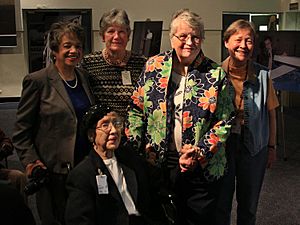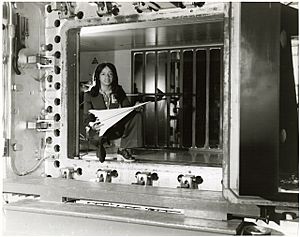Christine Darden facts for kids
Quick facts for kids
Christine Darden
|
|
|---|---|

Christine Darden in Langley's Unitary Plan Wind Tunnel in 1975. Credit: NASA
|
|
| Born |
Christine Mann
September 10, 1942 (age 83) Monroe, North Carolina, U.S.
|
| Alma mater | Hampton University Virginia State University George Washington University |
| Known for | Technical Leader of NASA's Sonic Boom Group |
| Awards | Dr. A. T. Weathers Technical Achievement Award, 1985 Senior Executive Career Development Fellowship, 1994 Candace Award for Science and Technology from the National Coalition of 100 Black Women, 1987 |
| Scientific career | |
| Fields | Aeronautical engineering |
Christine Darden (born September 10, 1942) is an amazing American mathematician and engineer. She worked for 40 years at NASA, studying how planes fly super fast. She also researched sonic booms, which are loud noises made by aircraft.
Christine Darden was the first African-American woman at NASA's Langley Research Center to reach the highest rank in the federal government's civil service. She is one of the inspiring scientists featured in the book Hidden Figures. This book tells the true story of the Black women mathematicians and engineers who helped NASA succeed.
Contents
Early Life and School
Christine Mann was born on September 10, 1942, in Monroe, North Carolina. Her parents, Desma Cheney and Noah Mann Sr., always encouraged her to get a good education.
When she was just three years old, her mom, a teacher, started taking her to her classroom. At age four, Christine went to kindergarten. She was so smart that she skipped a grade and went straight to second grade!
As a child, Christine loved taking things apart. She would even take apart her bicycle and put it back together. She finished high school at Allen High School in Asheville, North Carolina.
In 1958, she graduated as the best student in her class. She won a scholarship to attend Hampton University. In 1962, Christine graduated with a degree in Mathematics. She also became a certified teacher and taught high school math for a short time.
Fighting for Civil Rights
While studying at Hampton, Christine Darden joined early protests for the Civil Rights Movement. She participated in student sit-ins with other Black students. These protests helped fight against unfair segregation laws.
Her Career at NASA
In 1963, Christine Mann married Walter L. Darden Jr. In 1965, she became a research assistant at Virginia State University. She earned her master's degree in mathematics there in 1967.
That same year, NASA hired her to work at the Langley Research Center. Christine started in the "computer pool." This meant she was a "human computer," doing math calculations for engineers. She soon began writing computer programs to do these calculations automatically.
In 1973, Christine was promoted to an aerospace engineer. Her early discoveries in the 1960s and 1970s changed how engineers designed planes. Her work helped create aircraft that made quieter sonic booms. In 1983, Christine earned her Ph.D. in engineering from George Washington University.
In 1989, Darden became the leader of the Sonic Boom Team. This team was part of a bigger program called High Speed Research (HSR). Her team worked on ways to make sonic booms less noisy. They also tried to reduce their impact on the ozone layer. They tested new designs for airplane wings and noses. She even created a computer program to predict how sonic booms would behave.
The High Speed Research program was stopped by the government in 1998.
NASA's "Human Computers"

In 1935, NASA (then called NACA) started hiring African-American women as "human computers." Many men were fighting in World War II, so more jobs opened up for women. These women worked in a separate office called the "West Area Computers" because of segregation laws at the time.
These "human computers" did complex math to help design planes and, later, rockets. Because Virginia had Jim Crow laws, segregation was practiced at NASA's Langley Research Center. This changed after the 1964 Civil Rights Act, which made segregation illegal.
By the 1940s, these women were known for being essential to NASA's work. In the 1950s and 1960s, more of them got chances to become engineers and technicians.
Christine Darden joined the computer pool in 1967. By then, computers were becoming more common for calculations. In 1989, she left the computer pool to become an engineer. She focused on making supersonic flights quieter. She earned her PhD in 1983 with NASA's support. She became known as a top expert on supersonic flight and sonic booms.
Christine Darden was promoted to a manager. She became the first African-American woman at Langley to reach the Senior Executive Service. This is the highest rank for federal employees.
In March 2007, Christine Darden retired from NASA. She was the director of the Office of Strategic Communication and Education.
Interesting Facts About Christine Darden
- She earned a PhD in engineering from George Washington University in 1983.
- She has written over 50 articles about aeronautical design. She specialized in supersonic flow and how to reduce sonic booms.
Awards and Honors
- In 1985, she received the Dr. A. T. Weathers Technical Achievement Award.
- She won a Candace Award in 1987.
- She received three Certificates of Outstanding Performance from Langley Research Center.
- In 2018, she received the Presidential Citizenship Award from Hampton University.
- She received honorary degrees from North Carolina State University (2018) and George Washington University (2019).
- In 2019, Darden was awarded the Congressional Gold Medal. This is one of the highest civilian awards in the United States.
Christine Darden Quotes
- "I wanted to be in engineering. Men in engineering did research, gave talks, wrote and published papers, and got promoted. The women … followed the engineers’ orders."
- "I asked for a transfer to engineering, which my supervisor said was impossible. So I went to the director and asked why males and females with the same background were assigned different jobs. He said, 'You know, nobody ever asked me that question before.' I said, 'Well, I’m asking it now.' Three weeks later, I got promoted to engineering.
See also
 In Spanish: Christine Darden para niños
In Spanish: Christine Darden para niños


